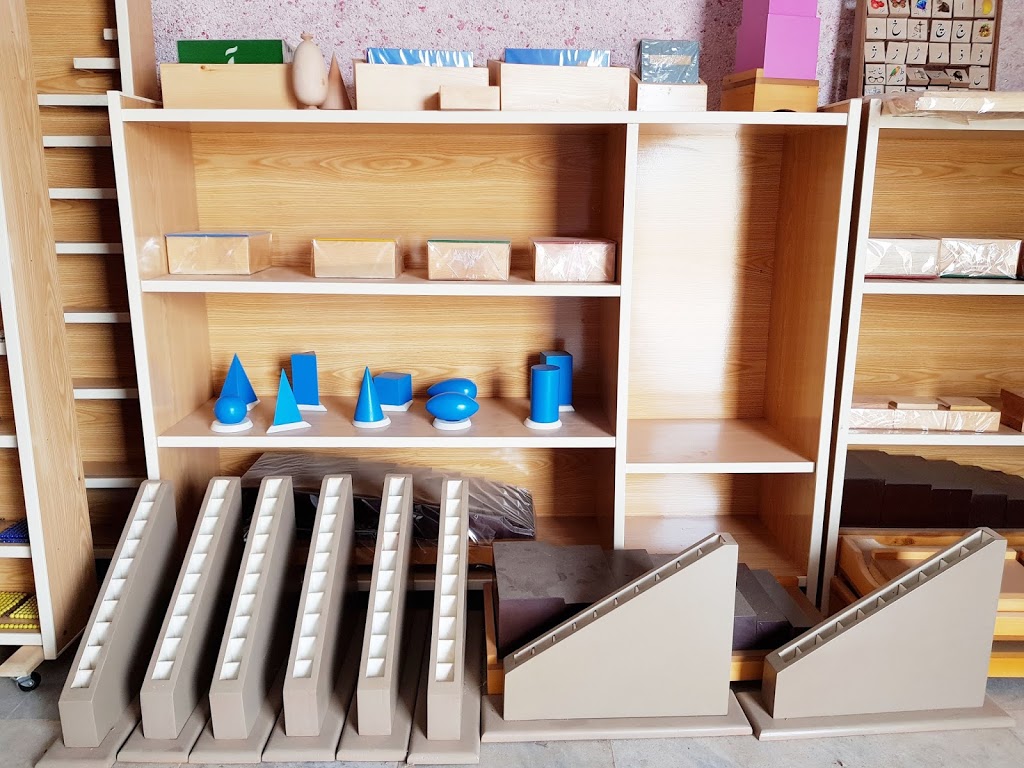
In Montessori Materials the Montessori Mathematics Material is performed by the individual, using self-teaching and self-correcting materials. These materials are presented to the kid as interest is expressed or observed then the adult moves away, to permit exploration through repetition, until the concept is mastered.
 |
| Montessori Mathematics |
To make a mathematical abstraction, the kid must have a prepared foundation of experiences of order, sequence, and sensorial experience of things round her . So it’s no accident that the essential materials of the Sensorial apparatus are supported the number of ten. Likewise, the world of Practical Life nurtures the mathematical mind of the kid through its precision and order. Montessori Mathematics Linear Linear Bead Cabinet Many materials with in the Montessori environment have indirect aims that contribute to the event of the mathematical mind.
 |
| Mathematics Linear Bead Cabinet |
The study of mathematics with in the elementary classroom continues to specialize in the utilization of manipulative materials that lead the kid toward abstraction, but differs consistent with the developmental characteristics of the 6 to 12 year-old child. Elementary aged children are socially oriented and luxuriate in using their ability to reason and to finish large, challenging projects.
Many exercises leave the likelihood of in depth work while the flexible structure of classroom time enables students to finish large projects and investigations. Presentations are usually given to small groups of children and repetition at this level is provided through a variety of activities including those initiated by the students themselves.
Montessori Mathematics Binomial Cube ,the materials used in the Montessori mathematics present ideas in concrete form and are sequenced to gradually move the student toward abstract comprehension. A material itself may offer various levels of difficulty to help the child reach an internalized understanding of a concept or the child may be moved toward abstraction by working through a series of materials that become increasingly abstract.
 |
| Montessori Binomial Cube |
In addition to directly preparing the child for the next material in a series of exercises, each material also provides a foundation for further mathematical activities by incorporating concepts that are absorbed by the child at a sensorial level.
For example, while the direct aim for a group of numerals cut from sandpaper is to introduce the symbols for the quantities from one to nine, the indirect aim is to physically prepare the child for writing the numerals at a later time. It is the buildup of sensorial knowledge, also because the child’s direct experience with sequential materials, that lays the inspiration for an abstract understanding of mathematical concepts in the Montessori system of education.
Montessori Mathematics and Activities :
The Montessori mathematics materials allow the child to experience concretely therefore, allowing an easier transition into abstract concepts. The Montessori math materials are tangible expressions of abstract ideas. The child moves from the sensorimotor materials by way of the red rods which allows him to experience short and long concretely, now he re-experiences this again in a new light with the red and blue rods. 10 is more or longer than 5, 1 is very little compared to 8…etc.
 |
| Montessori Geometric Solids |
The Montessori Mathematics materials are sensorial. The child sees 1000 beads male 1 cube and feel the heaviness and lightness of each. The child also feels that 10 is more than 7 when he holds all the spindles in his hands. The concept of zero becomes crystal clear when there is nothing in the compartment of 0. Montessori knew the child could understand 1000-9000 the way he could understand 1-9,and the 9 layout only reinforce this concept.
The hundred board does more than teach 1-100, it can teach skip counting families of 10, 20, etc. and act as an introduction to multiplication. Multiplication and division don’t become separate entities (though they are certainly different) a child will understand that to multiply is to add many times and divide is to subtract many times. This understanding becomes internalized without the child becoming aware of it.
As with Montessori materials the mathematics is performed by individual using
self-teaching and self correcting materials. These materials are presented to the child as interest is expressed or observed and then the adult moves away, to allow exploration through repetition, until the concept is mastered.
The formal Montessori mathematics curriculum begins with activities to teach sequence, recognition and quantity of numbers 1 through 10. Two parallel lessons formats build on this knowledge: operations with numbers (addition, subtraction, multiplication and division) and memorization of mathematical facts.
Eventually used together, these two disciplines form the foundation for working complex math problems. The mathematical exercises are presented during a logical sequence and systematic progress is formed from the concrete to the abstract.
The sequence of the presentations is respected and therefore the directress doesn’t allow herself or the kid to be rushed through the exercises. To proceed from one concept to the next, he needs to have fully established, understood and internalized the first.
Thanks for visiting my website, if you want to buy Montessori Materials Please visit www.montessori-specialist.com